Seasons > Easter > Decorations for the home > Living Room and Dining Room > List of items explained
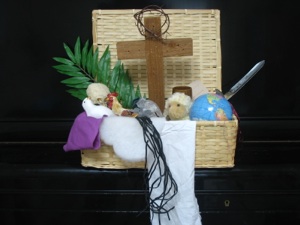



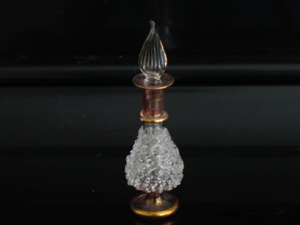






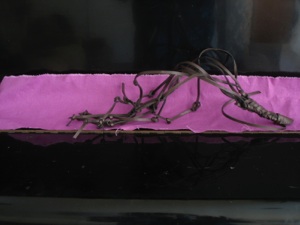

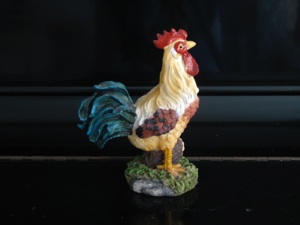



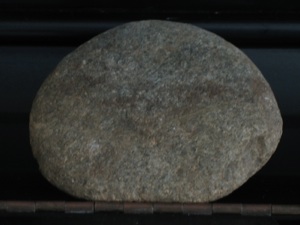

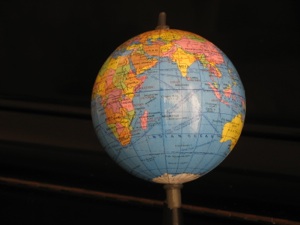
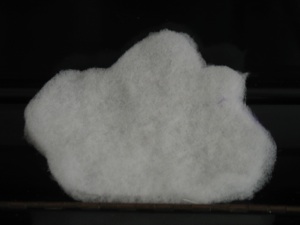


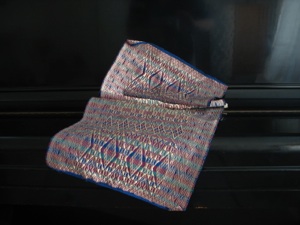

Seasons > Easter > Decorations for the home > Living Room and Dining Room > List of items explained
These items are too big to fit in Easter eggs for Resurrection egg sets, but they are the same kinds of objects. Several of these items can be grouped together for vignettes all over the house or church to make decorations that keep the focus on the true meaning of Easter.
Empty graves are a good way to keep Jesus’ resurrection central. Crosses are good, but they focus on Jesus’ death, and stop short of celebrating the glorious work of the resurrection. This grave is actually a planter that has been turned on it’s side. I put a round piece of black felt in the back to make it look like it has some depth.
If you can’t find a grave-style flower pot locally, you can make the grave and stone with a mixture of air drying clay with vermiculite (the sparkly stuff used in potting soil. If this mixture gets too dry, add some water. The vermiculite makes it look more like real stone, and the clay lets you easily make it any shape you want. Another option is to use a stone based clay that instructs you to air dry it, but if you bake it, becomes much harder. Another option is to mix vermiculite with plaster of paris and scoop out the hole before it hardens all the way. One more option is to make it out of paper mache. Crumple up paper bags or newspapers to form the basic shape. Then tear up more newspaper and glue it onto the basic shape with laundry starch, or a mixture of half glue and half water, or with a paste made of flour and water.
Triumphal Entry/ Palm Sunday: Donkeys are hard to find. All I can say is, keep looking. Coats and palm tree branches and stones can be added to the donkey, or used without a donkey. Cut silk leaves to look like palm branches (I used bamboo leaves here), and cut cloth into coat shapes.
Palm branches, occasionally sold at hundred yen stores, can be used in a lot of different ways. They can be used as simple centerpieces, or add silk flowers and ribbons or candles or crosses for decorations all over the house or church.
Dinner in Bethany when Jesus was anointed with perfume: For decoration purposes. a pretty bottle is good, but for teaching children, it is much more fun to have perfume inside for your children to smell or put on. Any bottle of perfume you have will be fine.
Cleansing of the temple: Any sheep or bird figurine will work for this. The cage shown here is actually an insect cage sold at hundred yen stores in the summer. This dove was sold in the wedding section of a craft store. A dove wouldn’t be too hard to make out of a clay such as Hearty.
Judas’ Betrayal: Spray paint 30 rocks silver, or use 30 silver coins. These coins don’t have to be a permanent part of the collection--you can spend them once Easter is over. You can make a pouch out of cloth or leather.
Last Supper/ Passover: Sheep figurines are plentiful around Christmas in America. This sheep was sold at Walmart to be used with a nativity set. You can often find plush toy sheep, especially Beanie Babies.
Plastic grapes (to represent wine) are sometimes sold at dollar stores. Any cup will do, since a goblet is really just a symbol, not what Jesus and his disciples actually used.
You can make fake Matza (unleavened bread) out of clay such as Hearty (Karui Kaminendo, sold at 100 yen stores.) Roll it out thin, poke rows of holes with toothpicks, and cut out a square shape with scissors or a knife. To make it more realistic looking, put dots of brown to make it look baked.
You can make real Matza by mixing flower and water, kneading, rolling it out thin, pricking it with a fork and baking it all within 18 minutes. To be Kosher, it also has to be made and eaten in a place where all yeast and baking powder and all products made with them are thrown out. Since I am not Jewish, and simply want my children to re-enact what Jesus did, I don’t throw everything out. It would be a great teaching tool if I did.
Garden of Gethsemane: “Silk” flowers can be one way to represent the garden. I bought these flowers in the tiny basket at a 100 yen store. They could be put into a small vase or bottle instead of a basket.
I found this wooden figurine and thought it represented Jesus’ distress as he prayed and waited in the Garden of Gethsemane. If you are artistic, you might be able to make a similar figurine out of wood or clay.
Praying hands can be another item to represent the garden of Gethsemane. They come in a wide variety of materials and designs in America. I think I got this one at an American dollar store. Other options: make out of clay, or take a photo of hands.
Jesus’ trial: A whip is fairly easy to make if you can find an inexpensive braided belt. They used to sell these at 100 yen stores. I cut them in half, unbraid them, then tie knots in each strand. So I was able to make two for a hundred yen.
You can make a crown of thorns from Pyracantha, rose, or a Yuzu tree. Cut off any leaves so you can see the thorns. Be sure to form it into a ring within a day or two of cutting a branch so it doesn’t get too brittle to work with.
Peter’s denial: Rooster figurines are pretty easy to find in America. This one was purchased at a dollar store. Occasionally you can find wooden cut-outs of chickens at hundred yen stores.
Jesus’ death: Cross. If you are not afraid of using a saw, or if you can get wood precut to the lengths you need, it can be quite inexpensive to make a cross.
Although I use this cross as a decoration, more importantly, I use it for a serious ceremony to celebrate Good Friday with my children to help them understand both the results of their sins and the forgiveness of their sins.
Soldiers cast lots for Jesus’ clothes: dice. If your 100 yen store doesn’t sell these, buy wooden blocks and draw the dots on yourself. You could sand the corners. Jesus offered vinegar to drink: piece of natural sponge on a bamboo skewers. Jesus’ death confirmed: sword. This one is a letter opener I found at a 100 yen store.
Temple curtain torn from top to bottom: brocade or any fancy cloth, preferably with red, blue, purple, and gold, as described in instructions for the temple in the Old Testament. I have not been able to bring myself to tear this in half, but it would be much more meaningful if I did.
Jesus’ burial and resurrection: Long white cloth. Since the cloth was all that was left behind at Jesus’ resurrection, I almost always use it along with items to represent an empty grave.
Soldiers cast lots for Jesus’ clothes: dice. If your 100 yen store doesn’t sell these, buy wooden blocks and draw the dots on yourself. You could sand the corners. Jesus offered vinegar to drink: piece of natural sponge on a bamboo skewers. Jesus’ death confirmed: sword. This one is a letter opener I found at a 100 yen store.
Jesus’ burial and resurrection: Stone
Rivers, beaches, and sides of roads are all good places to look for a flat round rock. You can make one by mixing air-drying clay with vermiculite (sparkley mixture added to potting soil.)
Jesus’ resurrection: Two angels appeared
Angels are easiest to find around Christmas, and almost always 100 yen stores have them with their Christmas decorations.
Jesus’ resurrection appearances: Jesus asked for something to eat when he appeared to the disciples in the locked room, and they gave him fish. Then he provided breakfast on the beach when the disciples had gone fishing. This fish was purchased at a hundred yen store. Though quite a bit smaller, you can often find fish shaped chopstick rests at hundred yen shops. When I display those, I use several, (though not the 138 the caught) and put them on top of a net bag that garlic is sold in.
Great commission: Jesus’ final recorded words before He went back to heaven were to tell the disciples to go into all the world and preach the Gospel. I thought a globe would be the best way to represent this. This globe was bought at a 100 yen store.
Jesus’ Ascension : Jesus disappeared from view into the clouds when he returned to heaven. Batting or cotton both make good cloud representations.
Passover/Holy Spirit descends on disciples/the church begins: There are various symbols that can be used for this. Since tongues of flame were on the disciple’s heads, a candle may be the most appropriate way to depict this. A dove is shown here, since a dove represented the Holy Spirit descending on Jesus at his baptism. This dove was purchased at a craft store in the wedding section. A ceramic church, purchased at a hundred yen store, represents the birth of the church.


